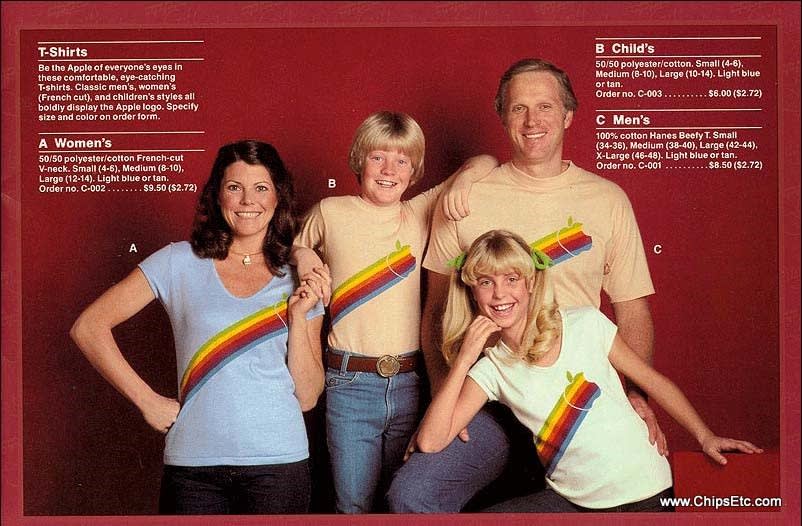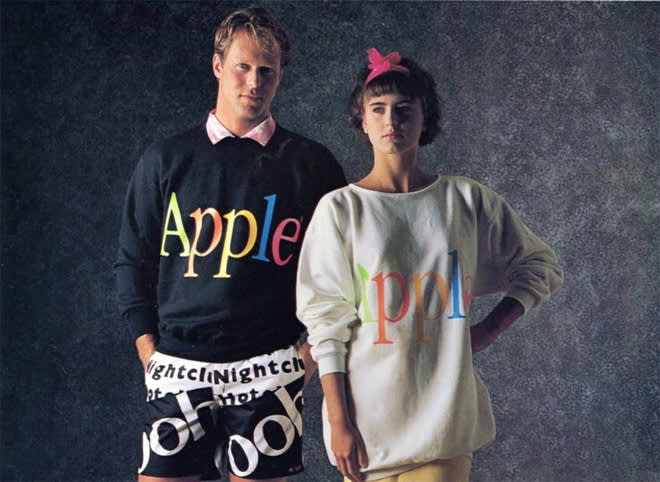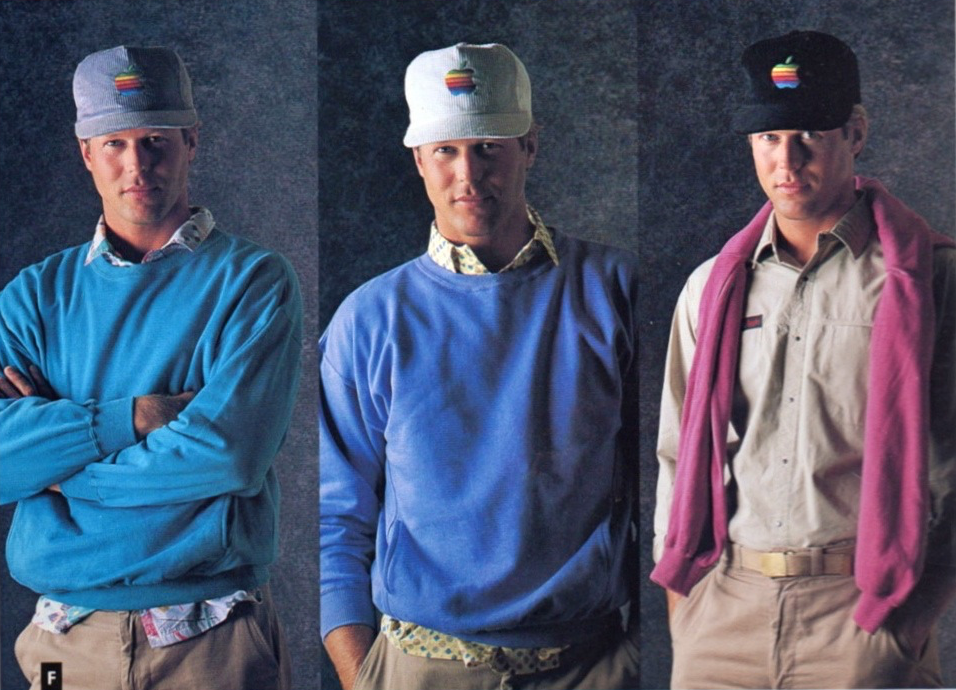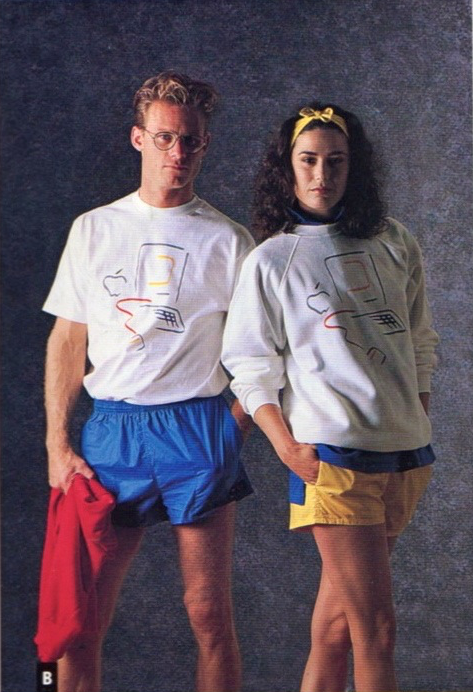Parallel Practices
Steve Jobs and Demna Gvasalia
The Apple Collection, Balenciaga and Vetements
Fashion
Balenciaga
Fall/Winter 2017 Menswear
The Apple Collection
Fashion captures the cultural zeitgeist of an era unlike any other creative industry. Aesthetic movements that characterize specific moments throughout history are the products of visionary thinkers, individuals who challenge convention and promote ingenuity. Without pushing boundaries there would be no innovation.
In 1986, ten years into his first tenure at Apple Computers, Steve Jobs, arguably the Einstein of the modern age, launched a clothing line called The Apple Collection. Jobs understood the power of the Apple brand and explored unchartered territory with a vision to advance his company into industries outside of technology. In its first year alone, 22,000 people purchased shirts from The Apple Collection, which soon included Apple-branded clothing, logo-adorned accessories and colorful lifestyle items. Jobs utilized the company’s cult like following to gage its influence in alternative, specialized industries.

Apple Computer Gift Catalogue
1983
Decades later, the importance of solidifying a committed fan base has never been more imperative to a brand’s success. The designer today who exhibits Jobs’ tactile approach to branding and strategic design is Demna Gvasalia. In a few short years, Gvasalia has cultivated god-like status through his work at Vetements, a company founded with his brother in 2009, and Balenciaga.
The Apple Collection garnered Steve Jobs the ability to explore design, branding and commerce in a space outside of technology, all while promoting awareness for Apple Computers. Each season, Demna Gvasalia continues to introduce innovative branding techniques while adjusting his approach to design. Four fundamental similarities exist between Jobs’ Apple Collection and Gvasalia’s work at Vetements and Balenciaga; these include:
1 - Collaboration 2 - Logo stricken apparel and accessories 3 - Branded ephemera 4 - Stereotypes/Irony
The Apple Collection
Tiffany
The Apple Collection
Snap Tops by Patagonia
The Apple Collection
Belts by Patagonia
The Apple Collection
Vests by Northface
The Apple Collection was a compilation of Apple-branded products – a curated catalogue of sorts - many of which were manufactured by well-known companies who were chosen by Jobs on the basis that they specialized in quality items that uphold the same standards of excellence as Apple’s existing products. Jobs partnered with a broad range of companies, from jewelry brand Tiffany, to automobile maker Honda, and active-wear brands such as Patagonia and North Face. Tiffany produced a crystal apple and an array of sterling silver products – all of which incorporated the Apple logo – Patagonia manufactured a snap shirt and cotton belts finished with an embroidered apples, while North Face, selected by Jobs’ for its product’s extreme durability, designed a duel-blend vest with double-entry zippered pockets.
Vetements Spring/Summer 2017
Vetements x Levis
Vetements Spring/Summer 2017
Vetements x Champion
Vetements Spring/Summer 2017
Vetements x Reebok
Vetements Spring/Summer 2017
Vetements x Juicy Couture
Vetements Spring/Summer 2017
Vetements x Manolo Blahnik
Vetements Spring/Summer 2017
Vetements x Canada Goose
While Steve Jobs approached collaboration strictly from a manufacturing position, there is a duality within the brand collaborations curated by Demna Gvasalia each season for Vetements; they exist as part production-driven decisions and part cultural riffs. For spring/summer 2017, Gvasalia showed a Vetements collection made entirely of other brands. Like Jobs, the designer selected collaborators he viewed as leaders in their specific fields; Brioni for tailored suits, Levis for jeans and jean jackets, Champion Sweatsuits, Reebok track pants and hoodies, Juicy Couture for velour, Canada Goose down jackets and Manolo Blahnik for high heels. Unlike Jobs’ collection, which relied heavily on Apple iconography to provide context, Gvasalia achieves a similar affect through exaggerated cuts and a reimagining of each collaborative brand’s trademark aesthetic; Manolo Blahnik, for example, produced thigh-high raw-edged satin boots, and sliced satin heels, while Juicy Couture’s velour and crystal tracksuits were reinvented in dress-form as evening wear. Gvasalia’s design approach is driven by the motive of twisting conventions, something he continually achieves each season through a carefully selected roster of collaborators.

The Apple Collection

The Apple Collection

The Apple Collection
Every item that existed under The Apple Collection umbrella of products was an exercise in branding, utilizing some version of Apple’s insignia. Aside from the company’s trademark logo, alternative text designs were developed which appear throughout The Apple Collection catalogue. The most basic items, simple sweatshirts and matching pants, spelled out “Apple” in colorful lettering, while a number of other designs included both the company’s logo and wordmark. The six-color Apple Logo was popular at the time and appeared on products such as varsity jackets and corduroy baseball caps. In addition to existing Apple branding, the company developed a suite of Memphis-inspired text designs that served as logos and colorful graphics. Aside from quality design, logo-mania was undoubtedly a primary focus of all products within The Apple Collection.
Vetements
Fall/Winter 2015
Vetements
Spring/Summer 2016
Vetements
Fall/Winter 2016
Balenciaga
Resort 2018
Balenciaga
Fall/Winter 2017 Menswear
Balenciaga
Fall/Winter 2017 Menswear
Balenciaga
Fall/Winter 2017 Menswear
In similar spirit to The Apple Collection’s vast array of iconography, Demna Gvasalia re-imagines the Vetements logo each season based on the attitude of the collection in focus. For Fall/Winter 2015 there was a reconstructed black sweatshirt with colorful text spelling VETEMENTS, in the style of lettering one might find on the jerseys of a high-school sports team. For Spring/Summer 2016 Gvasalia kept all branding pure, adorning boots and hoodies with simple white, sans-serif capital lettering, while for fall/winter 2016, Gvasalia developed a stylized wordmark of italicized letters outlined in white, akin to those used by cold-weather active-wear brands such as Quicksilver.
At Balenciaga, the designer incorporated the brand’s iconic block lettering on fur stoles for resort 2018 and on white leather shopping bags shown on the runway for fall/winter 2017 menswear. That same season, Gvasalia designed a red, white and blue logo riffing on Bernie Sander’s campaign graphics, spelling out ‘Balenciaga’ and ‘2017’, which adorned sweatshirts, blankets and varsity jackets.
The Apple Collection
Apple Coffee Mug
The Apple Collection
Apple Towel
The Apple Collection
Apple Umbrella
The Apple Collection
Enamel Tie Clip and Lapel Pins
The esteemed attention paid by Steve Jobs on the design and manufacturing of clothing within The Apple Collection translated down a hierarchy of products and into the land of branded ephemera and kitschy commodities. Come summertime, Apple and Macintosh Towels made of extra-thick velour and terry make for the perfect beach and poolside companions, while The Apple Collection’s sturdy umbrella is there to keep you dry in the rain. In addition, there was esteemed emphasis put on non-seasonal, everyday products such as ceramic coffee mugs, colorful, apple-shaped enamel key rings, tie tacks, logo lapel pins and Apple’s ‘Truck of the Future’ toy for kids. Although Steve Jobs thoughtfully selected each item included in The Apple Collection, in hindsight, as the products become cheaper and overtly branded, a lack of self-awareness begins to surface.
Balenciaga
Coffee Mug
Balenciaga
Snap Bracelet
Balenciaga
Lighter
Balenciaga
Eye Mask
Balenciaga
Pencils
Balenciaga
Coffee Mug
In contrast, Demna Gvasalia’s tactile work at the house of Balenciaga underscores his exceptional understanding of products and branding; case in point, the capsule collection the designer created on behalf of Balenciaga in collaboration with Collette in Paris. Gvasalia’s product offerings were not the high fashion, high price point items one might expect to find on the sales floor of a Balenciaga store, instead the designer made a well calculated mockery of the Parisian fashion house, producing ephemera stricken with the brand’s trademark iconography as well as his Bernie Sander’s campaign riff logo. In theory, walking into Colette anytime throughout the month of July 2017, one could find every item you already have at home, collecting dust in drawers and cabinets, but instead, these mugs, lighters, eye masks, pencils, snap bracelets, etc., all said ‘Balenciaga’. Well, this logical theory was disputed, the products quickly sold out and Demna emerged as a leader in the art of kitsch.

The Apple Collection
'The Heavyweights'

The Apple Collection
'The Tennis Players'

The Apple Collection
'The Runners'
The mind is inclined to stereotype. Taking a look back at fashion trends of any era, particularly the 1980s, it is hard not to. The imagination dreams up a compelling story when you first process a person’s clothing, facial expression and overall demeanor. The curation of The Apple Collection catalogue, groups what appear to be likeminded individuals based on their appearance, giving their ‘character’ or ‘stereotype’ a title; suggesting that if you are one of them, the Apple Collection is for YOU. Within the catalogue you can find the ‘Apple Heavyweights’ wearing polo shirts with popped collars and sunglasses, the ‘Runners’, in Apple activewear and rugged, lined shorts, and ‘Tennis Players’, with tan skin and Apple-branded, adjustable visors. Steve Jobs understood the power of an image better than anyone, and there is no irony lost in Apple’s cunning use of stereotypes to not only sell branded products, but to sell a lifestyle.
Vetements Fall/Winter 2017
'The PUNK'
Vetements Fall/Winter 2017
'The Office Woman'
Vetements Fall/Winter 2017
'The Tourist'
Vetements Fall/Winter 2017
'The Milanese Woman'
Vetements Fall/Winter 2017
'The Bouncer'
Vetements Fall/Winter 2017
'The Police Woman'
Vetements Fall/Winter 2017
'The Soldier'
While The Apple Collection explored entry-level irony in select images throughout their extensive catalogue, Demna Gvasalia devoted an entire Vetements collection to addressing the makeup of common stereotypes. The cast of characters, quite literally, that paraded down the brand’s fall/winter 2017 non-runway at the Pompidou Center in Paris, included everyday archetypes ranging from an office worker and rapper, to an Asian woman, a nightclub bouncer, a female police officer, a soldier, a PUNK, tourists, a middle aged Milanese woman and, for the finale, a bride. Unlike the use of stereotypes throughout The Apple Collection, which were utilized to sell product, Demna’s decision to design a collection around common archetypes was his way of mocking convention.
The similarities drawn between Steve Jobs’ approach to the design and marketing of The Apple Collection in the 1980s, and Demna’s current work at Balenciaga and Vetements are rooted in their likeminded creative focus. Both subjects embody the spirit of their respective times, proving them ideal case studies for understanding design and culture in two distinct eras.


